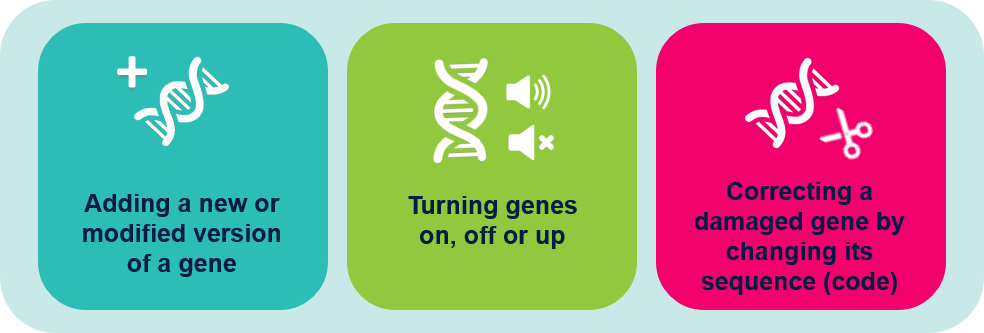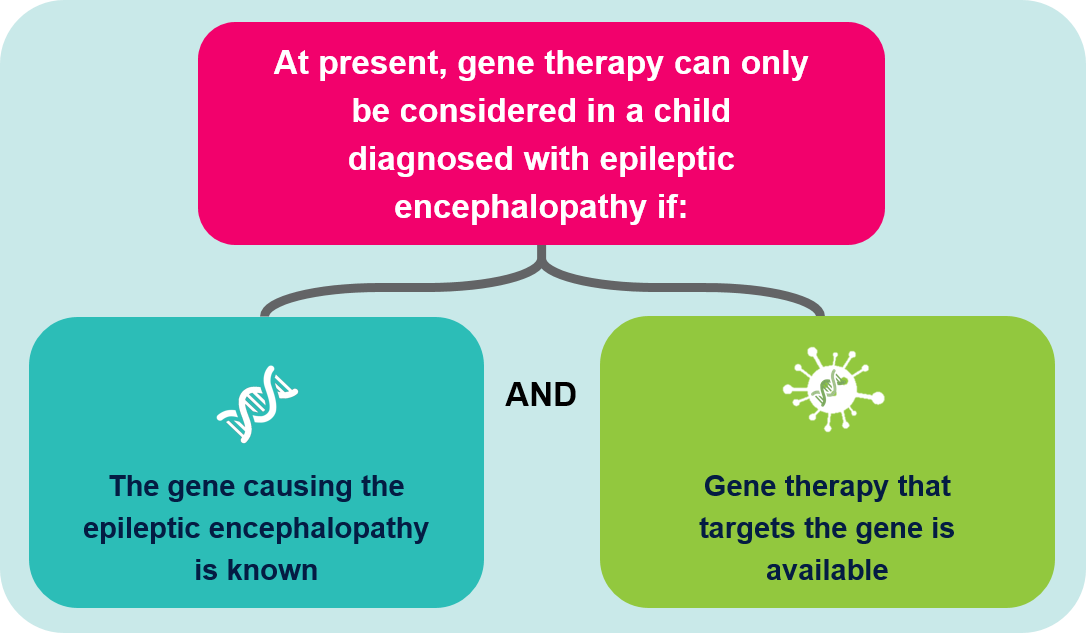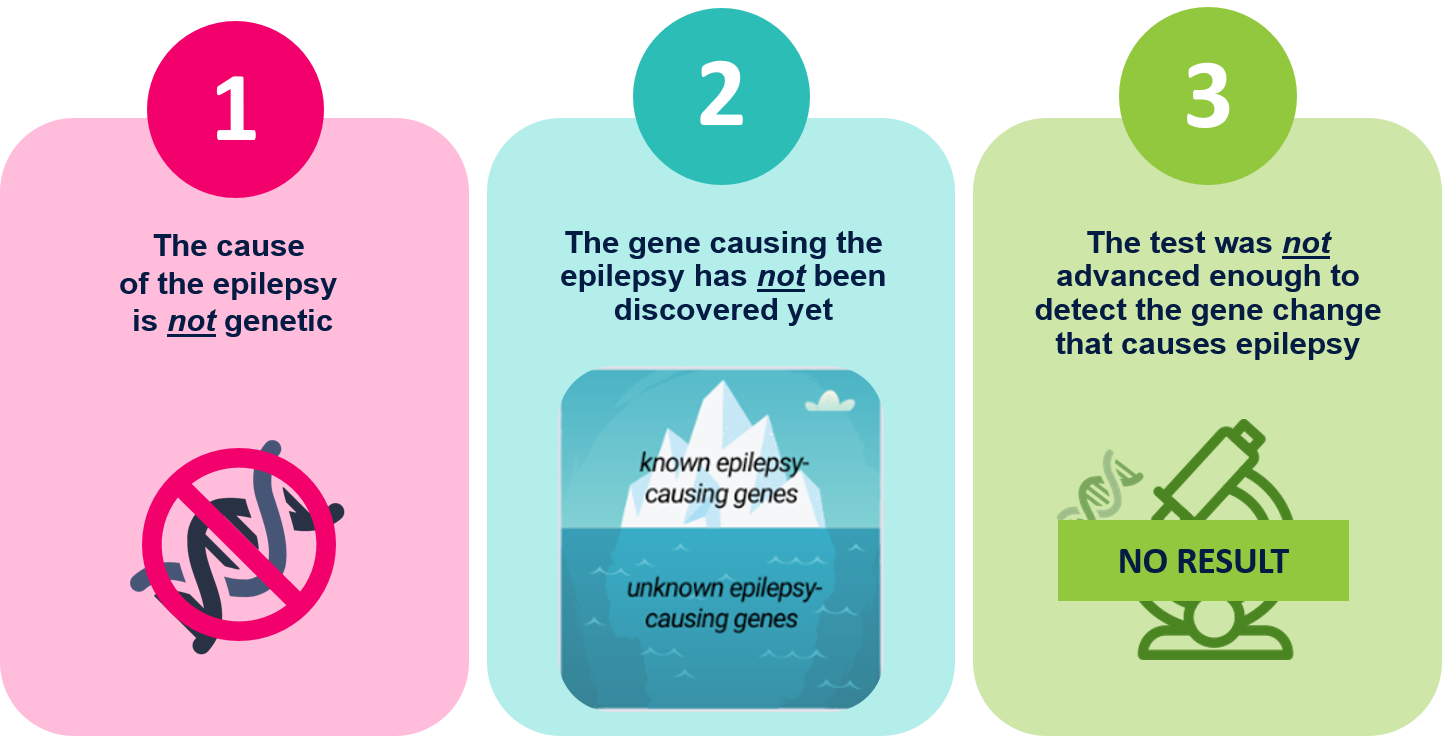About gene therapy
- We are made up of trillions of little units called cells. Examples of cells are our hair cells, heart cells and brain cells.
- Genes are the ‘instructions’ inside our cells that make proteins. Proteins are what make our bodies work.
- We all have variations in our DNA sequence (the code within our genes). These variations may be passed down from our biological parents, or they may occur in us by chance. Sometimes a variation in a gene can cause a health condition. Most of the time variations in genes do not cause any health problems.
- Gene therapy is a type of treatment that targets individual genes to treat or prevent a health condition.
- In genetic epilepsy, the overall goal of gene therapy is to correct the way the genes that cause a health condition function.
How gene therapy works
- Gene therapy works in one of several ways (see image below).
- In all types of gene therapy, the gene needs to be delivered to a person’s cells.
- This is done using a vector (vehicle), which is often a virus.
- The virus’s harmful effects are turned off before it is used as a vector.

Gene therapy is specific to the particular genetic change
- There is no ‘one size fits all’ gene therapy.
- Gene therapies need to be developed to treat each specific genetic change.
- The therapy is tailored to the specific gene affected and the type of change within the gene.
Development of gene therapy for individual genetic conditions
- Gene therapy is more complicated than regular treatments.
- It involves many steps:

- Delivering the gene to the right part of the body, such as the brain, can be difficult.
- The effect of gene therapy on seizures and other symptoms must be carefully studied in clinical trials in large numbers of people. Because of this, it will take many years for gene therapy to be ready for routine use in epilepsy.
- Some gene changes are very complex, making it difficult to develop gene therapy. Some conditions may never be suitable for gene therapy.
How relevant is gene therapy to a child with a diagnosed epileptic encephalopathy?

More specifically:
1. The gene causing the epileptic encephalopathy must be known:
- Presently, for gene therapy to work, the gene causing the condition (the ‘target gene’) must be known.
- Genetic testing is the only way to find a target gene.
- Your child may have had genetic testing but no result was found.
- Possible reasons for this are shown below:

- It may be possible to look at the data again or repeat the test, to find an answer. You can contact the genetics service you visited previously to discuss your options. You may also wish to discuss this further with your treating team at your next routine appointment.
- If your child has not had genetic testing, you may like to discuss this with your neurologist. If your neurologist thinks that your child’s epilepsy may have a genetic cause, they can refer you to a genetics service.
2. Gene therapy that targets the specific gene causing the condition must be available.
There are, as yet, no gene therapies approved or in clinical trials for any type of genetic epilepsy in Australia. However, research is ongoing, both in Australia and overseas, with the hope that one day some genetic epilepsies can be treated with gene therapy. What this means is:
- At this point in time, gene therapy is not available for children with a genetic epilepsy in Australia.
- If gene therapy does become available, a genetic diagnosis will be needed so the gene therapy can be targeted to the gene causing the epileptic encephalopathy.
What types of benefits can be gained from gene therapy?
- Gene therapy, if available, may reduce some children’s symptoms. It is not yet known whether gene therapy will be able to completely cure a complex condition like epileptic encephalopathy.
- For many genetic conditions, other types of treatments, such as targeted or ‘precision’ therapies (see below) may prove more successful than gene therapy approaches.
- Research is ongoing to find better treatments for children with and without a genetic diagnosis.
In genetic conditions, targeted or precision therapies are based on the specific genetic change.
The treatment may be a special diet, vitamins or medications that target certain proteins or pathways in the body.
------------
Content on this page was generated via the GenE Compass project. The following article provides more information about the project:
- Robertson EG, Kelada L, Best S, Goranitis, I, Grainger N, Le Marne F, Pierce K, Nevin, SM, Macintosh R, Beavis E, Sachdev R, Bye A, Palmer EE. (2022). Acceptability and feasibility of an online information linker service for caregivers who have a child with genetic epilepsy: a mixed-method pilot study protocol. BMJ Open, 12:e063249. https://doi.org/10.1136/bmjopen-2022-063249
References:
-
Kids Health: What is gene therapy: https://kidshealth.org/en/parents/gene-therapy.html
-
Boston Children's Hospital: What is gene therapy: https://www.childrenshospital.org/treatments/gene-therapy
-
Zimmern V, Minassian B, Korff C. A Review of Targeted Therapies for Monogenic Epilepsy Syndromes. Front Neurol. 2022;13:829116. Published 2022 Feb 17. doi:10.3389/fneur.2022.829116